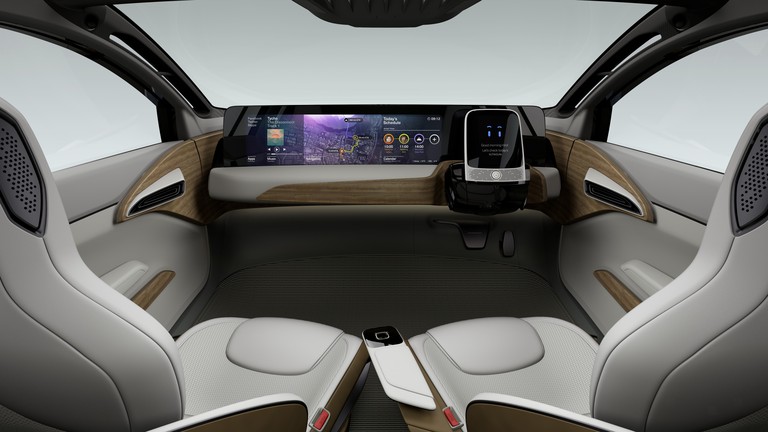VB: Do you think the driverless car is getting close, or is it still not very clear?
Curran: There’s a couple of angles to that question. The technology is making rapid advances. This is one case where the technology may even be outpacing our regulatory environment. A lot of CES is about showing off the art of the possible. You look at these autonomous cars, the proofs of concept are getting close. The legal questions and security questions and regulatory questions remain unresolved in the U.S., at the state and federal levels.
The industry has done a great job of making these cars safe, maybe even over-indexing in terms of keeping the speed limits set low and so on. But those are all things they can tweak to make sure the flow of traffic isn’t obstructed. The real question becomes, how do you make that practical in a real world setting? How do we make sure that, as a society, we’re ready to embrace it? All those stories will be in play at CES.
I saw a study by Intelligent Transportation Systems that estimated the self-driving market to be just about $34 billion over the next five years. People are putting large numbers on this in the relatively near term. Now the question is going to be getting all the pieces of the puzzle together at the right time.
At the very least, I’m happy to no longer have to parallel-park my car. I like pressing a button and having the car do it for me. I think consumers are eager to look at how to enhance the overall driving experience, in many cases potentially making it safer and more convenient at the same time.
VB: Can you talk more about your IoT predictions?
Curran: As the industry’s looking for growth, moving beyond those four traditional categories that have carried us over the last five to 10 years, a lot of the next-wave innovations have been focused around IoT. At the show last year, the hype and excitement around IoT was palpable. People saw it as a big potential moneymaker, a big wave of innovation.
Last year we unveiled our 2015 Digital Consumer Study. One thing we’d seen was consumer reluctance to embrace these new products. They felt they were a little too difficult to use, a little too difficult to get the full benefit out of them in their lives. The companies have done a good job over the last 12 months of addressing those challenges, making the devices and services more seamless, more fit for purpose, easier to get up and running.
One challenge we see this year, which is a new storyline around the space, is security. Over the last 12 to 18 months, consumers have started to tune in to questions around security, starting to have that influence their intent to purchase, products they buy, services they use, and so on. Originally, that manifested itself in online shopping, people having awareness of what was going on in more traditional commerce settings. Now, as the security story has gotten larger for consumers and their awareness has become more pervasive, they’re aware of just how much is being collected about them, how much of their information is potentially in play with some of these IoT devices.
We’re going to see a real focus on addressing consumer security concerns at CES, as a way to continue to attempt to unlock the potential of the IoT market and beyond. Last year was the first year we saw personal security designated as a type of exhibitor at CES. This year we expect 82 exhibitors focused on privacy. This has jumped to the fore over the last 15 to 18 months. It’s going to move into consumer awareness on issues like IoT, where you’re collecting information on a whole range of activities they wouldn’t have previously thought of as vulnerable.
VB: What about the slowdown predictions? It seems like tablets really did slow down, but the other categories I’m not sure about. PCs have slowed, but phones seem to be going all right.
Curran: If you look at the results over the last 12 months since we made that prediction, tablets and laptops both had slower years as far as growth than in the past. TVs have been in a similar situation.
You wouldn’t have called it a fantastic year for phones. A couple of players did exceptionally well. Much of the rest of the industry struggled. We’re finalizing our research right now for this year’s consumer study. We’ll be announcing this year’s results at CES. But assuming the final conclusions come through as we’re seeing right now, I’m expecting the trends we saw last year. Last year was the first time we saw a global drop in purchase intent across most of the major consumer electronics categories. I think it was nine out of 13 categories surveyed — including phones, tablets, laptops, computers, and HD TVs – seeing a drop.
In most cases that trend is continuing, and in some cases that trend is accelerating. We’re reaching market maturity in many of these categories. The industry is looking for what’s next, but we’re getting consumers in a new type of buying pattern. They’re in a refresh-and-replacement cycle, as opposed to net new purchases. Convincing consumers that now is the right moment to add a new one or retire the old one becomes a key part of the question.
Consequently, what we’re going to see at the show is many of these companies focusing on not just the new hardware, the new form factor, but also taking that a step further and talking about the new services that are available on these products. How can you take advantage of the innovations they’re putting in the hardware to make a practical difference in your life? There’ll be a pivot toward these new growth drivers being an integration of the services, the back-end analytics, and the device itself to create an experience for the consumer that’s rich and compelling.
VB: Drones just got a bit of bad news from the government as far as having to register.
Curran: Drones are a little like the self-driving car. We have technology innovations, but we have to make sure we’re keeping pace with the regulatory and legal environment. Certainly, it’s been an area where we’ve had some avid consumer uptake. Consumers are really enjoying it for photography and video. Real estate agents are using it to enhance their listings. People are exploring both personal and professional ways to exploit the technology. Of course, we’ve all seen the videos of fleets of drones delivering every product known to man.
The technology’s captured consumer interest. But now you have this case of how you balance consumer desires and the capabilities of the product with legitimate concerns? You don’t want drones too close to restricted airspace, adversely affecting planes on takeoff and landing. That will be an interesting story, the capabilities of the technology coupled with where it fits in the industry and where it fits vis-à-vis regulation.
VentureBeat's mission is to be a digital town square for technical decision-makers to gain knowledge about transformative enterprise technology and transact. Learn More





